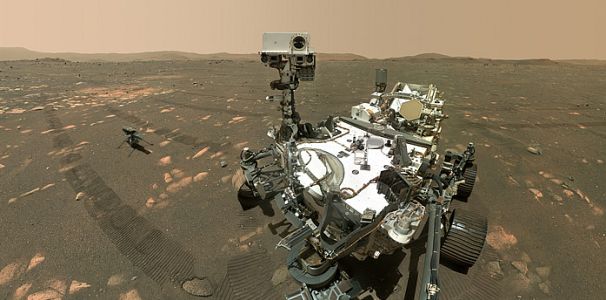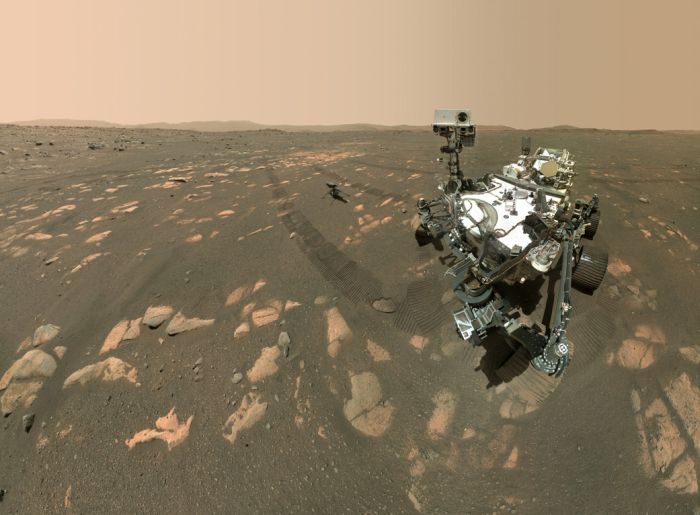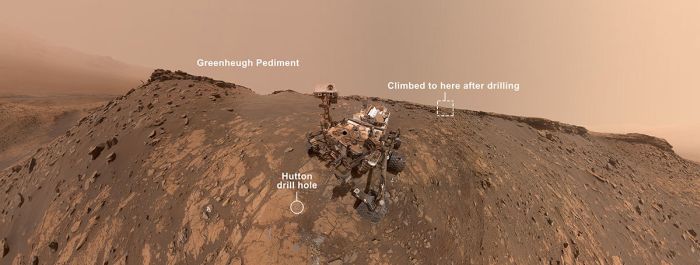
First Martian selfie of Perseverance Mars Rover with the Ingenuity helicopter

NASA’s Perseverance Mars rover took a selfie with the Ingenuity helicopter, taken about 13 feet away in this extra-terrestrial image from April 6, 2021, the 46th Martian day, or sol, of the mission. Perseverance captured the image using a camera called WATSON (Wide Angle Topographic Sensor for Operations and eNgineering), part of the SHERLOC (Scanning Habitable Environments with Raman and Luminescence for Organics and Chemicals) instrument, located at the end of the rover’s robotic arm.
Perseverance’s selfie with Ingenuity was stitched together from 62 individual images taken while the rover was looking at the helicopter, then again while it was looking at the WATSON camera. Videos explaining how NASA’s Perseverance and Curiosity rovers take their selfies can be found on the NASA website.

Once the team is ready to attempt the first flight, Perseverance will receive and relay to Ingenuity the final flight instructions from JPL mission controllers. Several factors will determine the precise time for the flight, including modeling of local wind patterns informed by measurements taken by the MEDA (Mars Environmental Dynamics Analyzer) instrument aboard Perseverance. Ingenuity will run its rotors to 2,537 rpm and, if all final self-checks look good, lift off. After climbing at a rate of about 3 feet per second (1 meter per second), the helicopter will hover at 10 feet (3 meters) above the surface for up to 30 seconds. Then, Ingenuity will descend and touch back down on the Martian surface.
Several hours after the first flight has occurred, Perseverance will downlink Ingenuity’s first set of engineering data and, possibly, images and video from the rover’s Navigation Cameras and Mastcam-Z, a pair of zoomable cameras. From the data downlinked that first evening after the flight, the Ingenuity team expects to be able to determine if its first attempt to fly at Mars was a success. Flight test results will be discussed by the Ingenuity team in a media conference that same day.
A key objective for Perseverance’s mission on Mars is astrobiology, including the search for signs of ancient microbial life. The rover will characterize the planet’s geology and past climate, pave the way for human exploration of the Red Planet, and be the first mission to collect and cache Martian rock and regolith (broken rock and dust).
Subsequent NASA missions, in cooperation with ESA (European Space Agency), would send spacecraft to Mars to collect these sealed samples from the surface and return them to Earth for in-depth analysis.
The Mars 2020 Perseverance mission is part of NASA’s Moon to Mars exploration approach, which includes Artemis missions to the Moon that will help prepare for human exploration of the Red Planet.
For more on this historic event, see the videos accompanying this article.
Sources: NASA, Andrew Good, Jet Propulsion Laboratory, Pasadena, Calif. & Karen Fox / Alana Johnson, NASA Headquarters, Washington
Posted by Richard Webster, Ace News Today / Follow Richard on Facebook and Twitter






